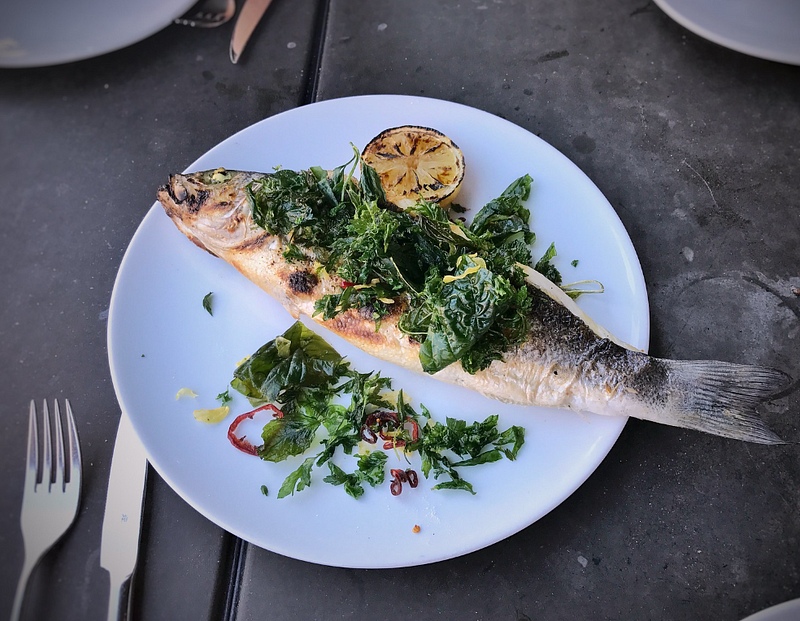The Rise of Branzino: From Ocean to Plate
Written on
Chapter 1: The Journey of Branzino
At a restaurant in northeastern Athens, a grilled whole European sea bass, known as branzino, was served. I turned to Socrates Panopoulos, a hatchery manager from Selonda, and asked, “What distinguishes wild sea bass from farmed ones?”
Before he could respond, his junior scientists jumped in. “The liver,” one suggested, noting that a dark red liver indicates a low-fat diet typical of wild fish.
Panopoulos countered, “But Kostas, they’ve removed the guts. What now?”
“Perhaps the otolith?” another scientist piped up.
“Ah, the otolith,” Panopoulos agreed.
He carefully extracted the ear bone from the fish’s head and, using his glass as a makeshift magnifier, counted its layers, which form like tree rings. “I see four layers, and they are uneven. This fish is four years old and wild.”
In contemporary Greece, such a wild catch is increasingly rare. Overfishing has significantly depleted wild European sea bass populations, making it a sought-after delicacy. Interestingly, in Greek culture, to express hitting the jackpot, one says they “caught a sea bass,” reflecting its once-abundant status. However, as wild fish numbers decline, the need to explore farming alternatives becomes evident.
The farming of sea bass has been in development since the 1960s, initially tested in France and Israel. Years of research into their reproduction and diet, combined with the favorable warm waters of Greece, transformed sea bass into a commercially viable product.
The Greek story of sea bass farming began with Thanasis Frentzos, who in 1982 set sail from Kefalonia—thought to be Odysseus’ Ithaca. Frentzos, who faced a devastating storm that wiped out 90,000 juvenile bass during his return from Sicily, successfully nurtured the surviving fish to maturity. This venture led to Greece becoming a leader in global sea bass production, with the Selonda company expanding its exports significantly in the early 2000s.
American interest in imported sea bass has surged as domestic striped bass populations have dwindled. Once a staple along the Atlantic Coast, striped bass faced severe overfishing, leading to conservation efforts in the 1980s that have allowed their numbers to recover somewhat, although they remain under threat. The current legal size limits make catching a plate-sized wild striped bass nearly impossible.
So, should we turn to branzino, the farmed alternative? The answer is complex. Farmed European sea bass, like salmon, raises environmental concerns, particularly the significant amount of smaller wild fish required to produce one pound of branzino. This practice poses risks to marine ecosystems. Some farms, like Kefalonia Fisheries, have adopted "organic" practices, using byproducts from wild fish processing, but critics argue this is just a temporary fix until more sustainable feed can be developed.
When choosing to consume branzino, consider the Mediterranean way of preparation. Unlike the American preference for fillets—which wastes a substantial portion of the fish—Mediterranean cuisine often serves whole fish, encouraging diners to savor every part. This approach not only reduces waste but also allows one fish to feed multiple people.
Marcella Hazan once expressed concern over Americans' aversion to whole fish, recalling a student's discomfort with fish “looking” at them. Hazan's response was straightforward: “It’s dead.” I echo her sentiment. If you opt for branzino, perhaps you should have the courage to acknowledge its presence.
An earlier version of this narrative appeared in the New York Times Magazine. For a more comprehensive exploration of the history and implications of European sea bass domestication, refer to part two of my book, Four Fish: The Future of the Last Wild Food.
Section 1.1: The Branzino Phenomenon

Section 1.2: American Striped Bass Conservation
Chapter 2: The Impact of Seafood Farming
In the video "Fish Schools Everywhere!" discover how fish farming has expanded and the various species that are thriving as a result.
The second video, "How to catch 'Here and There Fish' first try! | Dreamlight Valley," explores techniques for catching diverse fish, including branzino.